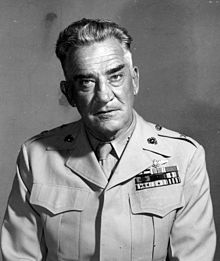Lawson H. M. Sanderson
Lawson Harry McPhearson Sanderson | |
|---|---|
 Sanderson as Brigadier General, USMC. | |
| Nickname(s) | "Sandy" |
| Born | July 22, 1895 Shelton, Washington |
| Died | June 11, 1973 (aged 77) San Diego, California |
| Place of Burial | |
| Allegiance | |
| Service | |
| Years of service | 1917–1951 |
| Rank | |
| Service number | 0-860 |
| Commands | 4th Marine Aircraft Wing 1st Marine Aircraft Wing Marine Aircraft Group 11 |
| Battles / wars | World War I Nicaraguan Campaign World War II |
| Awards | Legion of Merit Distinguished Flying Cross |
This article needs additional citations for verification. (October 2016) |
Lawson Harry McPhearson Sanderson (July 22, 1895 - June 11, 1973) was an aviation pioneer of the United States Marine Corps with the rank of Major General. He is most noted for his effort in development of the Dive bombing technique.[citation needed] As Commanding officer of the 4th Marine Aircraft Wing, Sanderson accepted the Japanese surrender of Wake Island at the end of the World War II.
Early career
He was born on July 22, 1895, in Shelton, Washington as the son of game warden Lewis Sanderson (1857-1941), and his wife Ruby (1861-1956). After attending the local high school, Sanderson enrolled at the University of Washington and subsequently at the University of Montana in Missoula, Montana, where he graduated with a Bachelor of Arts degree in 1917. He then enlisted in the United States Marine Corps in April 1917 and served as an enlisted man for one year.
Sanderson was transferred to Marine Corps Aviation during April 1918 and was assigned to Miami Naval Air Station, where he served first as Instructor,[citation needed] then was assigned to Pilot training. He was finally designated Naval Aviator on 14 January 1919 and commissioned Second lieutenant in the Marine Corps Reserve Flying Corps. He was sent overseas as a member of Squadron "E", which was attached to the 1st Provisional Brigade of Marines at Port-au-Prince, Haiti.
During the one of the skirmishes with "Cacos" bandits, Sanderson flying the Curtiss JN-4 plane was ordered to attack a group of bandits near the old stone French fort. Unfortunately his squadron did not receive requested bomb racks yet. Sanderson improvised canvas mail sacks instead of bomb racks. He subsequently dropped light bombs from shallow dive on the enemy and was successful in completing of the mission. Although Sanderson called it "Glide bombing", it helped develop the later Dive bombing technique.[citation needed]
He returned to the United States in February 1920 and was assigned for instruction at Officers Training School within Quantico Base, Virginia.
World War II

With the outbreak of World War II, First Marine Aircraft Group was expanded to the 1st Marine Aircraft Wing under the command of Colonel Louis E. Woods and Sanderson was appointed Wing Operations Officer. Wing was sent to the Pacific in September 1942 and subsequently participated in the Guadalcanal campaign. For his service in this capacity, Sanderson was decorated with Legion of Merit.
Decorations
Here is the ribbon bar of Major general Lawson H. M. Sanderson:

| |||
| Naval Aviator Badge | |||||||||||||
| 1st Row | Legion of Merit[1] | Distinguished Flying Cross[1] | |||||||||||
|---|---|---|---|---|---|---|---|---|---|---|---|---|---|
| 2nd Row | Navy Presidential Unit Citation with one star | Marine Corps Expeditionary Medal with two stars | World War I Victory Medal with clasp | Haitian Campaign Medal | |||||||||
| 3rd Row | Second Nicaraguan Campaign Medal | American Defense Service Medal with clasp | Asiatic-Pacific Campaign Medal with three service stars | American Campaign Medal | |||||||||
| 4th Row | World War II Victory Medal | China Service Medal | National Defense Service Medal | Nicaraguan Presidential Order of Merit with Gold star | |||||||||
Legion of Merit citation
The President of the United States of America takes pleasure in presenting the Legion of Merit to Colonel Lawson H. M. Sanderson (MCSN: 0-860), United States Marine Corps, for exceptionally meritorious conduct in the performance of outstanding services to the Government of the United States. From 17 October 1942 to 31 December 1942, Colonel Sanderson served as Operations Officer of the FIRST Marine Aircraft Wing at Guadalcanal, British Solomon Islands. In this capacity he was charged with the coordination, supervision and tactical employment of all Army, Navy and Marine Corps aircraft based at Guadalcanal. He repeatedly exposed himself to enemy bombing, shelling by ground artillery and naval guns, and on some occasions when shells were bursting within a very short distance, when it was necessary to the task at hand. His efficient conduct of the operations of our aircraft, combined with his coolness and devotion to duty under fire have provided an excellent example to all personnel associated with him.[1]
References
- ^ a b c "Lawson H. M. Sanderson". Hall of Valor. Military Times. Retrieved August 29, 2016.
- 1895 births
- 1973 deaths
- People from Mason County, Washington
- University of Washington alumni
- University of Montana alumni
- United States Naval Aviators
- United States Marine Corps generals
- American military personnel of World War I
- American military personnel of World War II
- People of the Banana Wars
- United States Marine Corps World War II generals
- Recipients of the Legion of Merit
- Recipients of the Distinguished Flying Cross (United States)
